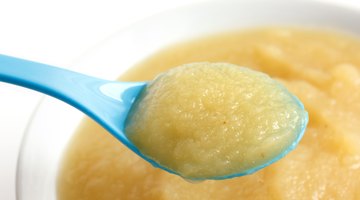Common Gerber Foods That Cause Rashes on Babies
Rashes and other symptoms caused by food allergies are common in babies, affecting around 1 in 18 children before they turn 3 years old. Around 90 percent of all food allergies in babies are caused by either cow's milk, soy, eggs, peanuts or wheat. Because peanuts often cause such serious allergic reactions, Gerber does not put peanuts in its baby food. However, many Gerber products contain food that can cause allergies.
Gerber Food with Cow's Milk
Many babies who are allergic to the protein in cow's milk are also allergic to goat, sheep and soy milk. Symptoms, from rashes to stomach aches, usually appear by 3 months old and can occur almost immediately, or more commonly, as long as 10 days after consumption.
Gerber products with cow's milk include many "Graduates," "2nd Foods," "3rd Foods" and "Lil' Entrees" foods, including all pastas, crackers and yogurt cereals.
Gerber Food with Soy

Foods to Avoid While Nursing a Baby With Eczema
Learn More
Most babies reveal an allergy to soy by 3 months of age, and if your child is allergic to soy she may also be allergic to cow's milk. Many pediatricians recommend not introducing soy to babies before 6 months of age.
Gerber food with soy products include most pastas, cereals and crackers, often marked with the labels "2nd Foods," "3rd Foods" and "Lil' Entrees."
Gerber Food with Egg
Most children with egg allergies are actually allergic to the egg white's protein, although some children are also allergic to yolk proteins.
Many Gerber "2nd Foods," "3rd Foods" and "Lil' Entrée" products, including all pastas and most crackers, contain eggs.
Gerber Food with Wheat

Kiwi Allergy Symptoms
Learn More
If your baby has a wheat allergy, her body overreacts to one (or several) of the proteins in wheat, including gluten, gliadin, and most typically, globulin and albumin.
Wheat-containing Gerber products are numerous, and include most cereals, pastas, crackers, fruit and granola mixes, vegetable or fruit and rice mixes, fruit puffs, granola and cereal bars and cookies.
Symptoms
In babies, food allergies often show up as a red or whitish rash on the face, limbs or chest. A long-lasting eczema rash is also possible, usually looking like red or brown patches of skin that are extremely itchy. In more serious cases, hives (itchy or burning pink or red raised areas of skin, sometimes with a whitish center) appear.
Other symptoms of food allergies in babies include loose stools (sometimes with blood or mucus), diarrhea, constipation, excessive gas, gagging or vomiting, refusing to eat, colic, ear infections, stuffy nose, runny nose or red or watery eyes.
With severe food allergies, anaphylactic shock is possible. Symptoms include swelling of the airways, tongue, and/or mouth; bluish skin around the mouth; difficulty breathing; wheezing; and violent and repetitive vomiting or diarrhea. If this happens, call 911 immediately. Do not drive your baby to the emergency room because he requires immediate ambulance treatment.
Treatment
The only way to diagnose and treat babies is by avoiding allergens. For babies eating solids, eliminate one food at a time (carefully reading labels) to see if you can pinpoint the troublesome food. All allergens are required by law to be listed clearly on the label. When introducing new foods to your baby, wait 3 or 4 days between new foods, watching closely for any rashes.
If your baby has a history of allergies, have a bottle of children's Benadryl handy in case of a strong reaction. Your pediatrician can tell you what dosage is correct for your baby's weight.










